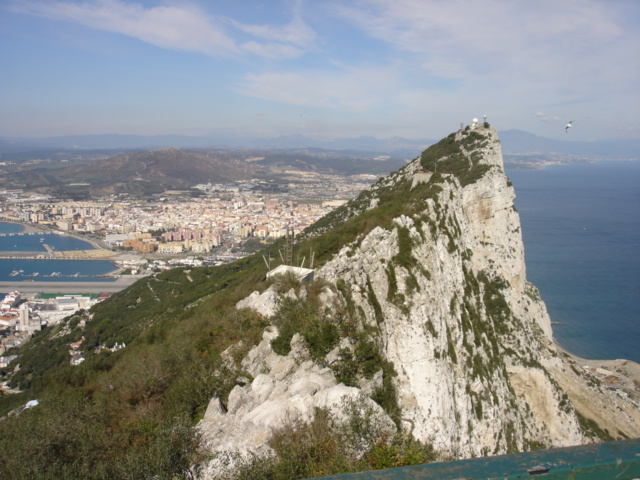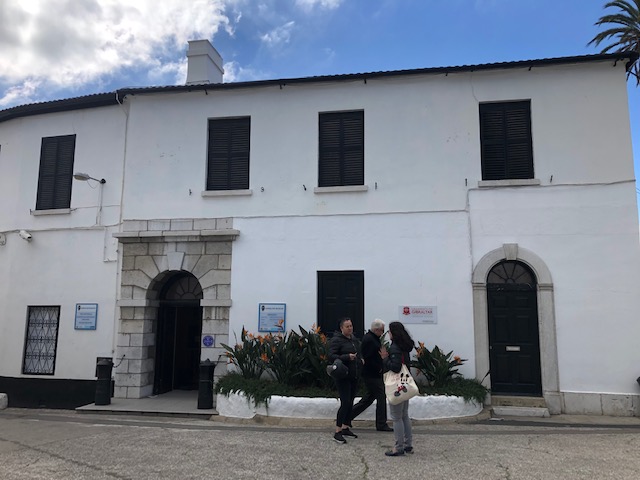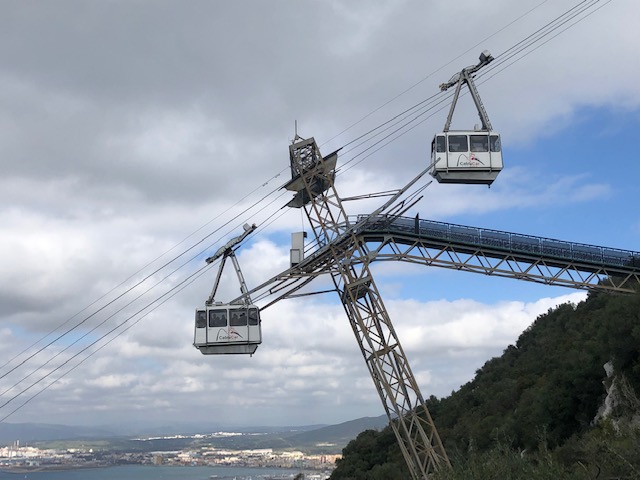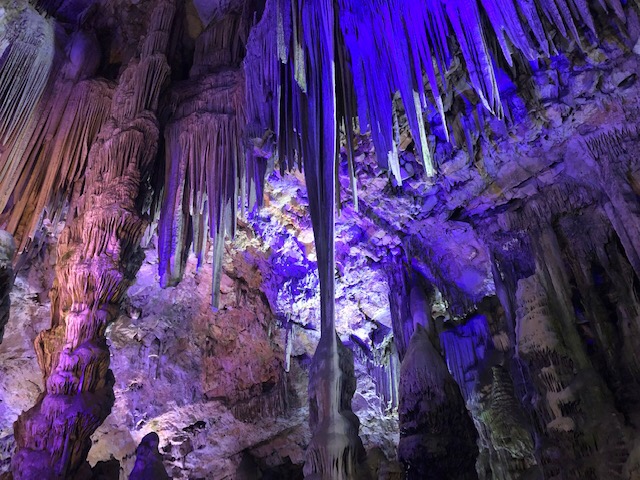
Like Contributing Writer Robert Waite, I was also thrilled to finally set foot on the Rock of Gibraltar — in our case, it was a few years ago, when my wife and I approached it by sea from Morocco.
Previously, we had passed it a few times while crossing the Straits of Gibraltar from Spain to North Africa, but from a distance all you see is a…rock. Not that it isn’t an impressive rock — one time I wasted almost an entire roll of film trying to photograph it from too great a distance — but when you approach it it quickly becomes apparent how alive it is with people and activity.
I’ll let Bob take it from here — with a hearty recommendation that you visit when you can.
By Robert Waite

Gibraltar – If someone calls you a Neanderthal, don’t take offense. Odds are, unless you are sub-Saharan African, you carry about 1.5% to 2.1% of your humanoid cousin’s genes.
Perhaps because it is now understood that they are, at least in part, us, Neanderthals have been experiencing something of a reputational rehabilitation.
Gone is the image of the brutish “cave man.” In its place is a more nuanced picture of a being capable of fashioning tools and creating art.
In recent years, whole issues of Scientific American, episodes of the PBS program NOVA, and best-sellers like Yuval Noah Harari’s “Sapiens” have shed new light on a species that emerged about 350,000 B.C.E. and ran out of runway about 30,000 years ago.
One of the best places to experience this reality is Gibraltar. Its Gorham Cave served as a final sanctuary for a people whose domain once covered much of southern Europe and the Middle East.
The cave allows only very restricted visits, but the Gibraltar National Museum in town brings you face-to-face with Flint and Nana, life-like renderings of two of the inhabitants of the cave, a child and a grandmother.
Created by Kennis & Kennis — Dutch twins who famously combine science, including DNA analysis, forensic reconstruction and formidable artistic skill — you are confronted with life-like individuals.
If they suddenly moved, you would not be entirely surprised.
The Gibraltar Museum has other interesting aspects, but in commissioning the brothers – Adrie and Alfons – in 2016 to fashion Flint and Nana, it has vaulted to must-see status.
The Original “Rock”

Gibraltar had always been a place I planned to visit.
“The Rock”, as it is often referred, loomed large in my memory, whether from Prudential Insurance ads (“Strong as the Rock of Gibraltar”) on the flickering black-and-white TV screen of my youth or the various WWII histories depicting the British-controlled outcropping as vital to maintaining allied Mediterranean access.
But although I’ve visited the Iberian Peninsula numerous times, it was not until relatively recently, with an extended stay near Fuengirola in the south of Spain, that I finally achieved my objective.
Traveling by vehicle along the coast, you catch frequent glimpses of the 426 m (1,396 ft) limestone promontory well before reaching the Spanish-British frontier. It is unmistakeable – a shape as familiar as the Matterhorn or Mt. Fuji.
But unlike Fuji or the Matterhorn, Gibraltar’s “Rock” is still an active British military outpost – there are areas you will not be able to visit.
But no matter – there is more than enough to see and do, from some of the best shopping in Europe, to some great vistas (including, on a clear day, a glimpse of Africa across the strait), to a chance to wander through some of the world’s most elaborately illuminated caverns.

Runway Dodge Ball
However, before you get to all that, you must enter Gibraltar from Spain by crossing an active airport runway. Britain’s tiny (2.6 sq. mi.) overseas possession was captured by Anglo-Dutch forces in 1704 and ceded, in perpetuity, to the U.K. by Spain in 1713.
It didn’t take long for the Spanish to realise perpetuity is a very long time indeed and they’ve at various points thrown up roadblocks – actual and metaphorical – to try to get the Brits to decamp.
Among other things, they resisted any attempts to cede additional land for a more logical airport location.
Once safely across the runway – no worries, it is well choreographed – you come to a central parking area from whence most tours depart and end.
Having a soft spot for caves and caverns, we headed first to St. Michael’s Cave. There are actually two levels, the Upper Caves and, for the somewhat more adventuresome and fit, the more recently discovered Lower Caves.
Although not as large as Kentucky’s Mammoth Cave or as delightfully weird as New Zealand’s Waitomo Cave (with its glow worms), St. Michael’s is still well worth your time. Unlike some cave complexes, it is not claustrophobic and the illumination of the stalactites and stalagmites is a thing of beauty.

Monkey Business
It is quite probable that outside the St. Michael’s entrance you will encounter so-called “Barbary Apes”.
These curious and often mischievous simians are not actually apes, but macaques, the only wild monkey population in Europe. For centuries it was believed by otherwise reasonable Greeks, Romans and Moors that they made their way from the Atlas Mountains in Morocco to Gibraltar via an undersea passageway of some sort.
Truth is, they didn’t – but no one knows exactly how they did. What you need to know is that they are cunning thieves and will steal your glasses, hat, purse or backpack in a nanosecond. So be forewarned. (Guard your plastic shopping bags — the macaques identify them with food.)
Among other things, you should consider taking the Gibraltar cable car, a tramway that in six minutes takes you up in elevation 213 meters to the Top of the Rock and a nearby nature reserve. You’ll encounter more monkeys, but, if the weather cooperates, be rewarded with spectacular views.
The downside of the cable car is its cost – it is expensive, especially when combined with a visit to the reserve. The latter provides an opportunity to see the WWII siege tunnels and also provides another approach to St. Michael’s caves, so you still might want to pony up the money.

Shoppers Paradise
Speaking of money, one of the great attractions of Gibraltar is shopping. This is a true duty- and tax-free jurisdiction.
As a heavily taxed Canadian-based writer who frequently worships at the altar of the New Hampshire State Liquor Store when stocking up on Scotch whisky, I can personally attest Gibraltar has the lowest prices ever encountered. This goes for all manner of things, not just alcohol.
When I returned to my apartment in Fuengirola, I uncorked my bottle, poured a wee dram, and toasted a fine day’s visit to The Rock – and to my newly met Neanderthal cousins, Flint and Nana.
IF YOU GO
A number of airlines fly into Gibraltar, including British Airways.
Should you wish to enter from the south of Spain, there are many tours offered by companies on the Costa del Sol.
North Americans do not need a visa to enter Gibraltar, but you will need your passport. Spain and the U.K. are in the final stages of ratifying a post-Brexit agreement to keep the border between the two open to allow continued free movement – which is in the interest of both, as thousands of Spaniards migrate across the border to work and shop each day.
English is Gibraltar’s official language, but Spanish (and a Spanish-English hybrid called Llanito) are also widely used.
As mentioned, the Cable Car is expensive, but they do offer reduced rates for seniors. Also, you can choose to ride up and walk down – a pleasant option – which will save you some money.
Gorham’s and Vanguard Caves are spectacularly sited on the eastern shore of Gibraltar. However, they are moderately difficult to access on foot. No visits are allowed within 48 hours of bad weather, and visits may have to be postponed at short notice if the weather is adverse.
Areas of the sea cave complex that can be visited and numbers of visitors allowed may vary from time to time. The standard tour, for up to five people, is to the entrance of Gorham’s Cave, but not inside, in order to protect the fragile archaeological deposits. All visits must be escorted by guides from the Gibraltar National Museum. Weekly tours down to the sea caves are typically available between 1st July and 31st October, weather permitting, with prior arrangement.
If I were to go again, I would have opted to stay overnight. It has been my experience that staying in a place at night offers a different perspective, as most of the tourist hordes have departed, leaving the place to settle back into its own pace and persona.
Author Bio: Contributing writer Robert Waite has written on travel for nearly 50 years; his previous posts for clarknorton.com include such far-flung destinations as Namibia, Rwanda, Albania, Cambodia (Angkor Wat), Laos, and Guatemala. He is also a professor at Seneca College in Toronto and Managing Partner at Waite + Co., a communications consulting firm with offices in Boston, Ottawa and Toronto.
Editor’s Note: You might also like my own, earlier view of Gibraltar, here.












Leave a Reply